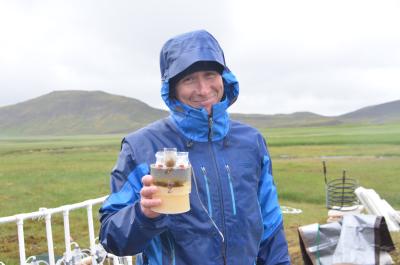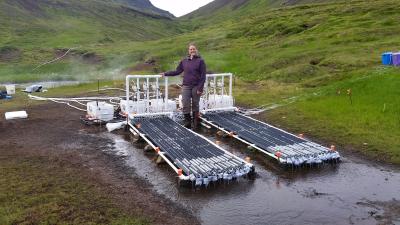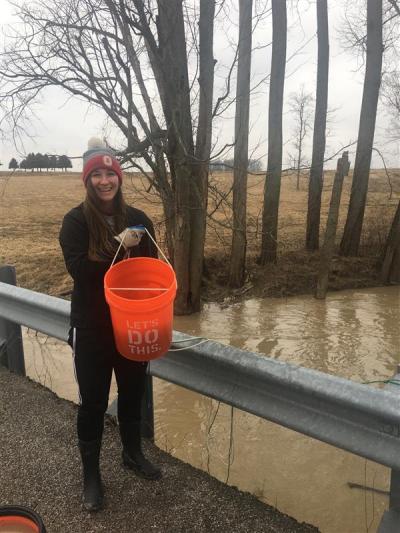
Like most faculty, I am an avid collector of titles. I am an Assistant Professor in EEOB, core faculty in the Translational Data Analytics Institute and a co-director of EEOB’s Aquatic Ecology Laboratory. I am also a father of two girls (6 and 8), a mountain bike racing coach for kids 4-14 and a freshwater ecosystem ecologist. The latter title I take to mean that I get to study whatever strikes me as interesting about rivers, lakes and someday maybe even wetlands.
Growing up in Iowa, my career was inspired by early opportunities to explore nature close to home as well as on hunting, fishing, SCUBA diving and hiking trips with my family that spanned from Iowa corn fields to the Caribbean to the north shore of Alaska. While I was an undergraduate at Lawrence University in Appleton, Wisconsin, I was lucky to find fantastic mentors in Bart DeStasio (Lawrence University) and Tom Frost (University of Wisconsin) who inspired me to study zooplankton (tiny invertebrates less than a millimeter that swim around in lakes, eat algae and are often eaten by fish) and limnology (the study of inland waters).

I have been lucky to make limnology my life’s work. I earned a master’s degree from Miami University studying the role of fish in the nutrient cycles of Venezuelan streams and then a PhD focusing on the role of invertebrates in nutrient cycling in streams draining redwood forests in California while also using zooplankton to test more theoretical ideas. When I earned my PhD, my wife and I packed up our meager possessions and moved to Reykjavik, Iceland, where I conducted research that used geothermal streams to understand how climate warming and nutrient pollution influences stream ecosystems. This work continued after I came to Ohio State and supported Lyndsie Collis as my first master’s student.
My lab in EEOB studies how climate change and nutrient pollution influences freshwater organisms and ecosystems, currently with a focus on Lake Erie and its tributaries. Our work in Lake Erie seeks to understand the drivers of short- and long-term change in algae and zooplankton to increase understanding of the ecology and management of the Great Lakes. Much of this work leverages the Lake Erie Plankton Abundance Study (LEPAS), which was initiated by Dr. Dave Culver (emeritus professor, EEOB) and the Ohio Division of Wildlife. LEPAS, which I now manage, has been monitoring algae and zooplankton communities in Lake Erie since 1995. My group has been using LEPAS data to understand how algal and zooplankton communities have changed over time, how they are influenced by declining ice cover associated with climate change, and the role that zooplankton play in mitigating or enhancing harmful algal blooms.

We also study how agricultural ditches, streams and rivers shape phosphorus exports to Lake Erie. This is an important knowledge gap because it could influence phosphorus and harmful algal bloom management. For example, if river sediment is a phosphorus source, releasing phosphorus over time to Lake Erie, then instream processes could undermine U.S. and Canadian efforts to reduce P loading to Lake Erie and mitigate harmful algal blooms. Our preliminary research indicates that rivers are phosphorus sources and sinks depending on where and when you look. Work by Whitney King (EEOB, master’s degree in 2020) has demonstrated that during high flow events, which deliver more than 80% of the phosphorus that fuels harmful algal blooms, streams and rivers in the Maumee watershed decrease the delivery of bioavailable P to Lake Erie, potentially constraining harmful algal blooms.
The research we conduct has been rewarding because we get to collaborate with state managers to improve water quality in Ohio and Lake Erie. Recently, I got an opportunity to contribute to Science and Solutions, a group of researchers, watershed managers and agricultural extension experts from Ohio, Indiana and Michigan focused on improving communication about research on best management practices. We created a soon-to-be-public infographic about the role of legacy phosphorus and rivers in shaping P exports to downstream ecosystems. I’ve also gotten an opportunity to serve as a technical expert for the Ohio Environmental Protection Agency Lake Erie Aquatic Life Use criteria and for the Maumee River total maximum daily load development.
I teach Conservation Biology (EEOB 4410) and The Climate Crisis (EEOB 2911); two subjects I am passionate about. The Climate Crisis is an interdisciplinary course I team-teach with faculty from history and earth science. We cover the mechanisms of climate change, the history of human-climate interactions, the impact of climate change on humans and nature, and mitigation options. Interacting with undergraduate students about these topics has been exhilarating.
